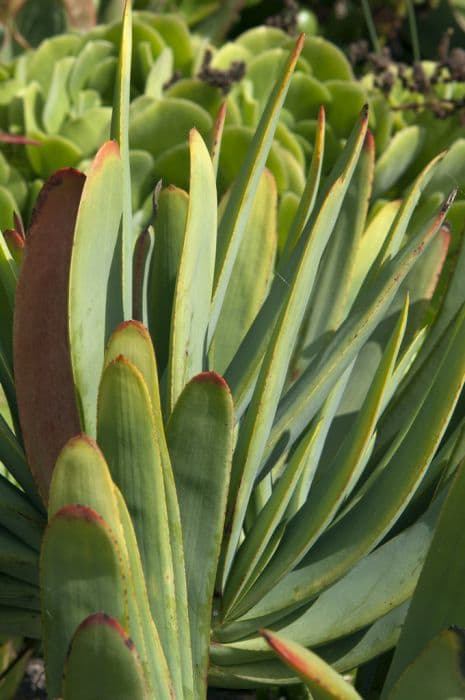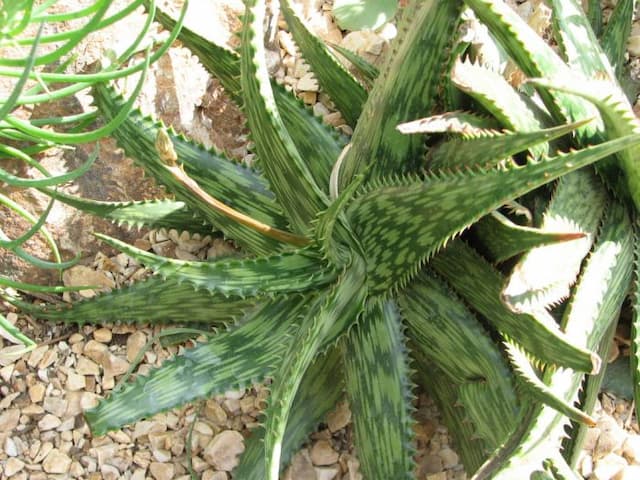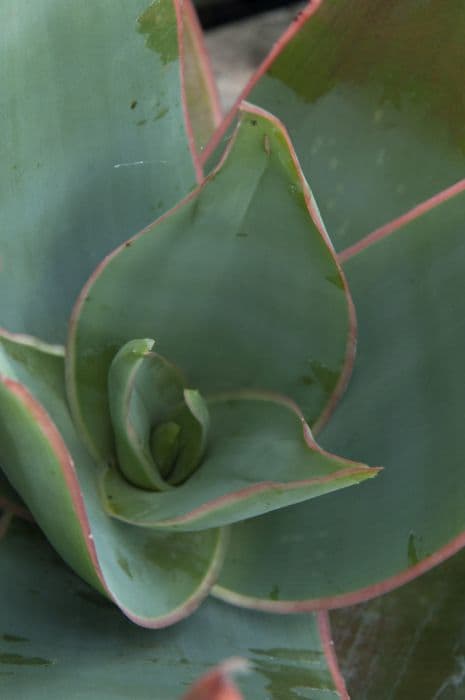Bulbine Bulbine frutescens

ABOUT
The Bulbine frutescens, commonly known as the stalked bulbine or orange bulbine, is a succulent plant characterized by its fleshy, green, aloe-like leaves. These leaves have a smooth texture and are arranged in a rosette formation at the base of the plant. The plant is known for its long flowering stalks that arise from the center of the leaf rosette. The stalks proudly bear small, star-shaped flowers that are usually yellow or orange in color, giving the plant one of its common names, orange bulbine. These blooms are clustered at the top of the stalks, which may branch out as they grow. The contrast between the green, succulent leaves and the vibrant flowers creates an appealing visual in any garden or container planting. The flowers and leaves both have a delicate and somewhat succulent appearance, contributing to the ornamental charm of the plant.
About this plant
 Names
NamesFamily
Asphodelaceae
Synonyms
Bulbine, Stalked Bulbine, Rankkopiva, Cat's Tail, Burn Jelly Plant
Common names
Anthericum frutescens, Bulbine caulescens, Bulbinella caulescens, Bulbine rostrata.
 Toxicity
ToxicityTo humans
Bulbine frutescens, commonly known as Bulbine, is not known to be toxic to humans. There is limited information on its edibility, but there are no widespread reports of poisoning or adverse effects from handling or ingesting this plant. Therefore, it is generally considered safe for humans, but as with any plant, individuals should exercise caution and avoid ingesting plant material if its effects are not well known or if they have a known allergy to similar plants.
To pets
Bulbine frutescens, commonly known as Bulbine, is not widely reported to be toxic to pets either. Although comprehensive data might be lacking, there is no significant evidence to suggest that this plant is poisonous to cats, dogs, or other household pets. However, it's still prudent to prevent pets from ingesting plants, as individual animals might have unique sensitivities or allergic reactions. If a pet does consume Bulbine and exhibits unusual symptoms, it's important to consult with a veterinarian.
 Characteristics
CharacteristicsLife cycle
Perennials
Foliage type
Evergreen
Color of leaves
Green
Flower color
Yellow
Height
1-2 feet [30-60 cm]
Spread
1-2 feet [30-60 cm]
Plant type
Herb
Hardiness zones
9
Native area
South Africa
Benefits
 General Benefits
General Benefits- Low maintenance: Bulbine frutescens is drought-tolerant and requires minimal care, making it ideal for low-water gardens and busy gardeners.
- Attracts wildlife: The plant produces yellow or orange flowers that attract bees, butterflies, and other pollinators, enhancing biodiversity.
- Groundcover: Its clumping habit and spreading nature make it a good groundcover, which can help prevent soil erosion and suppress weeds.
- Landscape versatility: Bulbine frutescens can be used in rock gardens, borders, or as a container plant, offering flexibility in garden design.
- Fast-growing: The plant grows quickly, providing a rapid green effect in garden spaces that need to be filled in or covered.
- Drought resistance: Being a succulent, it can survive prolonged dry periods, which is especially beneficial in arid climates and during water restrictions.
- Long blooming season: It has a long flowering period, often blooming throughout warm months, which ensures color in the garden for an extended time.
 Medical Properties
Medical Properties- Wound healing: Bulbine frutescens is traditionally used for its ability to aid in the healing of wounds. This property is attributed to compounds such as knipholone, which are found in the plant's sap.
- Anti-inflammatory: The plant contains compounds that have been reported to possess anti-inflammatory properties, making it potentially useful for reducing inflammation.
- Antimicrobial: It has been used traditionally to fight infections due to its antimicrobial activities against a range of microorganisms.
- Skin care: Due to its soothing properties, Bulbine frutescens is used in treating blisters, insect bites, and rashes, promoting skin recovery.
- Burn relief: The sap of the plant has been used to provide relief from burns and promote the healing process.
- Antioxidant: The presence of antioxidants in the plant suggests that it might help in combating oxidative stress and supporting skin health.
 Air-purifying Qualities
Air-purifying QualitiesThis plant is not specifically known for air purifying qualities.
 Other Uses
Other Uses- Bulbine frutescens, commonly known as Stalked Bulbine, can be used as a natural pest repellent in gardens, as its sap can deter certain insects and pests.
- The juice from its leaves can be used as a mild detergent for cleaning purposes, owing to its saponin content.
- Cut Stalked Bulbine leaves can be placed in vases to add a green accent to floral arrangements due to their long-lasting nature post-harvest.
- The plant's fleshy foliage can be used in crafting, specifically in making botanical prints or in paper-making for texture.
- Stalked Bulbine can be planted as a companion plant in vegetable gardens to create a microclimate that retains soil moisture.
- The plant can serve as a "living mulch" when grown densely, suppressing weeds and reducing soil erosion.
- Its thick succulent leaves can be mashed and mixed with water to make a nature-inspired glue for light bonding applications.
- Gardeners can use this plant to form natural borders or edges in landscaping, as it forms tidy clumps that retain their shape.
- Stalked Bulbine's aesthetically pleasing appearance and low maintenance make it a suitable plant for public spaces and urban greening projects.
- The dried seed pods of Stalked Bulbine can be used in decorative crafts or as part of dried flower arrangements for a rustic look.
Interesting Facts
 Feng Shui
Feng ShuiThe Stalked Bulbine is not used in Feng Shui practice.
 Zodiac Sign Compitability
Zodiac Sign CompitabilityThe Stalked Bulbine is not used in astrology practice.
 Plant Symbolism
Plant Symbolism- Healing: Because of its medicinal properties, Bulbine frutescens, also known as Stalked Bulbine, is often associated with healing. Its sap can be used on cuts, burns, and other skin ailments, symbolizing the plant's ability to aid in recovery and soothe pain.
- Resilience: Stalked Bulbine is known for its ability to withstand harsh, dry conditions, making it a symbol of resilience and the ability to endure through difficult times.
- Protection: In some cultures, it is believed that Stalked Bulbine has protective qualities, symbolizing safeguarding against negative influences and promoting a safe environment.
 Water
WaterThe Bulbine frutescens, commonly known as the Stalked Bulbine, is a drought-tolerant plant that requires minimal watering. In the growing season of spring and summer, water it once every 1-2 weeks with about 1 gallon per plant per watering, allowing the soil to dry out between waterings. In fall and winter, reduce watering to once every 2-3 weeks as the plant goes dormant. Overwatering can lead to root rot, so it is important to ensure that the plant is not sitting in soggy soil. Allow the top inch of soil to dry before adding more water.
 Light
LightStalked Bulbine thrives best in full sun to partial shade conditions. The ideal spot is in an area that receives at least 6 hours of direct sunlight daily but is also shielded from the intense afternoon sun in very hot climates. Dappled or filtered sunlight throughout the day is also suitable for healthy growth.
 Temperature
TemperatureStalked Bulbine prefers warmer temperatures, with an ideal range between 60 and 75 degrees Fahrenheit. It can handle temperatures down to about 20 degrees Fahrenheit, but frost and prolonged freezes should be avoided. It's not frost-hardy, so if temperatures dip below freezing, provide protection or move the plant indoors if it's in a container.
 Pruning
PruningPrune the Stalked Bulbine mainly to remove old flower stalks and dead foliage, which encourages new growth and a tidy appearance. Pruning is best done in late winter or early spring before new growth begins. This plant may only need an annual tidying up unless growth is particularly vigorous, in which case pruning can be done as needed.
 Cleaning
CleaningAs needed
 Soil
SoilStalked Bulbine thrives in a well-draining, sandy or gravelly soil mix with a slight acidic to neutral pH between 6.0 to 7.5. A mixture combining equal parts of sand, perlite, and potting soil works well for this drought-tolerant plant.
 Repotting
RepottingStalked Bulbine should be repotted every two to three years or when it has outgrown its container. It is a relatively low-maintenance plant that does not require frequent repotting.
 Humidity & Misting
Humidity & MistingStalked Bulbine prefers dry to average humidity levels and can tolerate arid conditions well, reflecting its native habitat, which does not have high humidity.
 Suitable locations
Suitable locationsIndoor
Ensure bright light, rare watering, and good airflow for Stalked Bulbine.
Outdoor
Plant in sunny spot, well-drained soil, protect from heavy frost.
Hardiness zone
9-11 USDA
 Life cycle
Life cycleBulbine frutescens, commonly known as the Stalked Bulbine or Burn Jelly Plant, begins its life cycle when seeds germinate in spring or early summer, given sufficient moisture. The seedlings grow rapidly and develop fleshy leaves that store water, allowing the plant to survive in arid conditions. In its juvenile phase, the plant establishes a strong root system and starts to form clumps with new rosettes. Flowering typically occurs from spring to fall, where yellow or orange star-shaped flowers bloom on long stalks and are pollinated by insects, leading to seed formation. After the flowering season, the plant may go dormant in excessively hot or cold periods, resuming growth with favorable conditions. Bulbine frutescens is a perennial and can live for several years, during which it can spread through rhizomes, creating dense mats that may require thinning.
 Propogation
PropogationPropogation time
Spring-Early Summer
The most popular method for propagating the Bulbine frutescens, commonly known as the Stalked Bulbine or Burn Jelly Plant, is by using stem cuttings. Ideal propagation time is in the spring or early summer when the plant is actively growing. To propagate, select a healthy, non-flowering stem and cut a 4 to 6-inch (about 10 to 15 cm) piece, making sure it has several nodes. Let the cutting dry out for a day to form a callus, which helps prevent rot when planting. Then, plant the cutting into a well-draining soil at a depth where it can stand upright and water it lightly. Roots should begin to develop within a few weeks, after which the plants can gradually be acclimated to more sunlight and less frequent watering as they grow.









